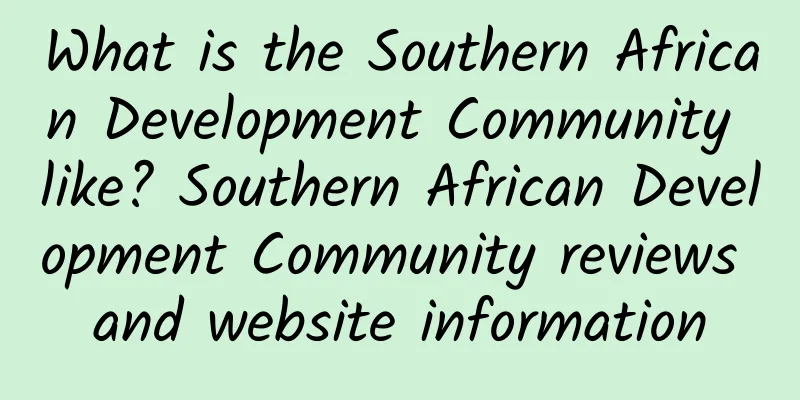What is the Southern African Development Community like? Southern African Development Community reviews and website information

|
What is the Southern African Development Community? The Southern African Development Community (SADC) is a regional economic organization in Africa. It was formally established in 1992 and is headquartered in Botswana. It aims to promote trade and investment among member countries and achieve regional economic integration. Website: www.sadc.int Southern African Development Community: A pioneer in promoting regional economic integrationThe Southern African Development Community (SADC) is one of the most influential regional economic organizations on the African continent. It was formally established in 1992 and is headquartered in Gaborone, the capital of Botswana. As an important cooperation platform in southern Africa, SADC is committed to achieving the goal of regional economic integration by promoting trade, investment and economic cooperation among member countries. The origin of SADC can be traced back to the Southern African Development Coordination Conference (SADCC) established in 1980. At that time, the main goal of this organization was to reduce the economic dependence of member countries on the apartheid regime of South Africa and strengthen economic cooperation in the region. With the end of the Cold War and the changes in the political landscape of Africa, SADCC transformed into SADC in 1992 and expanded its focus from simple economic coordination to a wider range of regional integration. SADC's Aims and ObjectivesSADC’s core mission is to enhance the competitiveness and sustainable development of the entire region by strengthening economic ties among its member states. Its specific goals include:
In order to achieve these goals, SADC has formulated a series of policy frameworks and action plans, such as the SADC Free Trade Area Agreement, the SADC Industrialization Strategy and the SADC Regional Infrastructure Development Plan. These documents provide member states with clear cooperation directions and implementation paths. SADC’s Organizational StructureSADC's organizational structure consists of multiple levels to ensure transparency and effectiveness of the decision-making process. The main institutions include:
SADC also has dedicated mechanisms to deal with peace and security issues, such as the Organ on Politics, Defence and Security Cooperation, which aims to resolve disputes between member states through dialogue and mediation. SADC Member StatesAs of now, SADC has 16 member states, covering most of the countries in southern Africa. These member states include Angola, Botswana, the Democratic Republic of the Congo, Lesotho, Madagascar, Malawi, Mauritius, Mozambique, Namibia, Seychelles, South Africa, Swaziland (formerly known as Swaziland), Tanzania, Zambia and Zimbabwe. These countries have significant differences in geography, economy and socio-cultural aspects, but they are committed to strengthening cooperation and achieving common development through the SADC platform. The combined population of SADC member countries exceeds 300 million and the total GDP is close to 1 trillion US dollars, making it one of the most important economic cooperation bodies in Africa. Major achievements of SADCSince its establishment, SADC has made remarkable progress in many areas:
In addition, SADC has also played an important role in responding to climate change and protecting biodiversity. By formulating regional environmental policies and action plans, SADC helps member countries better adapt to and mitigate the impact of climate change. Challenges facing SADCDespite certain achievements, SADC still faces many challenges:
To meet these challenges, SADC needs to further strengthen coordination and cooperation among member states and seek more international assistance and technical support. SADC official websiteThe official website of SADC is www.sadc.int . This website is an important channel for learning about the latest developments, policy documents and cooperation projects of SADC. The website is rich in content, including news releases, research reports, statistics and relevant information of member countries. By visiting the SADC official website, users can obtain the following information:
The SADC official website is not only an important window for the organization's external publicity, but also a key resource for academic researchers, enterprises and investors to understand the current status of regional cooperation in southern Africa. Future prospects for SADCLooking ahead, SADC will continue to deepen the process of regional economic integration and strive to achieve the following goals:
The success of SADC is not only related to the prosperity of its member states, but also has important significance for the development of the entire African continent. As a regional economic organization full of vitality and potential, SADC is moving towards closer and more sustainable regional integration. In short, the Southern African Development Community is a regional organization dedicated to promoting regional economic integration and sustainable development. By strengthening cooperation among member states, SADC has made important contributions to economic growth, social progress and environmental protection in southern Africa. Despite many challenges, SADC's prospects are still bright, and its efforts will inject new impetus into the overall development of the African continent. |
<<: How is the American Anthem company? American Anthem company reviews and website information
Recommend
Side effects of lotus leaf wax gourd peel
Lotus leaf wax gourd peel is a common health tea ...
Medicinal effects and functions of watermelon
Watermelon is not only edible but also can be use...
What is the University of California, Santa Cruz like? University of California, Santa Cruz reviews and website information
What is the website of University of California, S...
What flowers can't be placed indoors?
Placing some flowers and plants indoors is a favo...
What are the effects of red jujube tea? What are the effects and functions of red jujube tea?
Red date tea is the most popular fruit tea in lif...
Can babies eat leeks? Can babies eat leeks?
Leek is a common vegetable with high nutritional ...
What is Murata Manufacturing like? Murata Manufacturing reviews and website information
What is Murata Manufacturing? Murata Manufacturing...
How to make fatty meat delicious and not greasy
Fatty meat is very common in life, but most peopl...
Bekaert_How is Bekaert? Bekaert_Bekaert reviews and website information
Bekaert_What is Bekaert? Bekaert is a multinationa...
What is the German Science Foundation like? German Science Foundation reviews and website information
What is the German Science Foundation website? The...
How is Maxis Gaming Company? Maxis Gaming Company Review and Website Information
What is the Maxis Games website? Maxis is an Ameri...
How to distinguish fresh mangosteen from fresh
This kind of tropical fruit is only found in the ...
What is the nutritional value of free range eggs? What are the benefits of eating free range eggs?
Free range eggs are a common nutritious food in l...
The efficacy and function of blueberry anthocyanins
Blueberry is a small, bright blue delicious fruit...
Ingredients and method of shrimp and winter melon soup
Have you ever eaten dried shrimp and winter melon...









